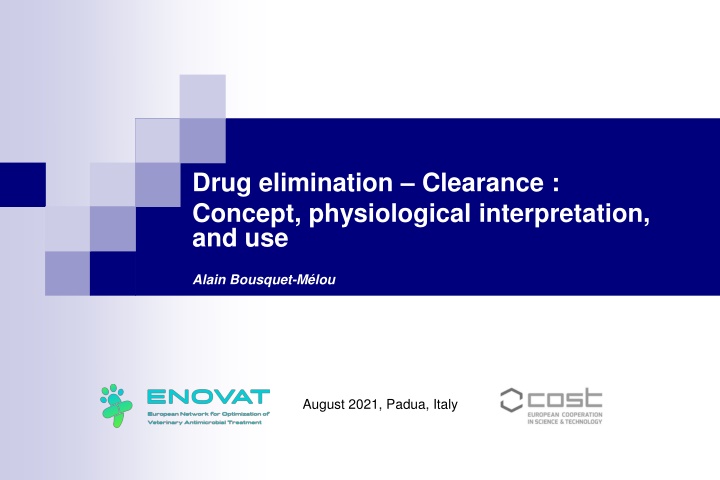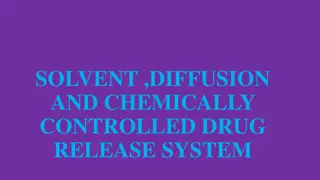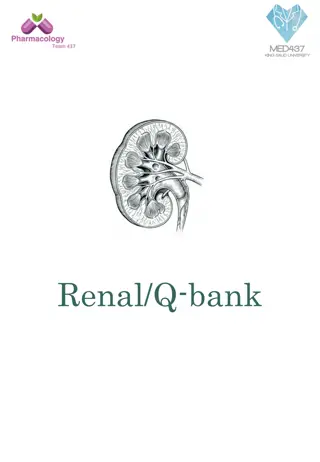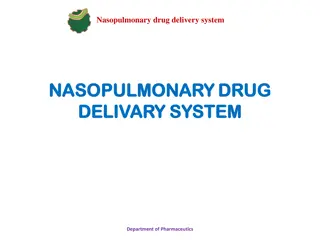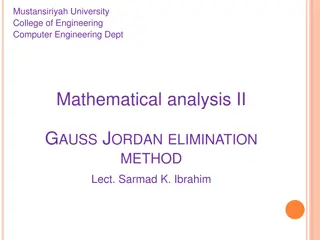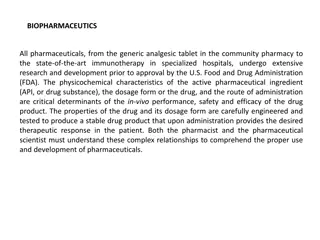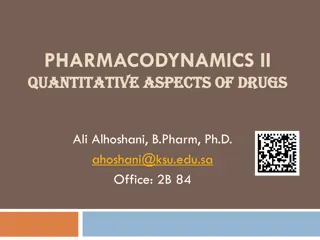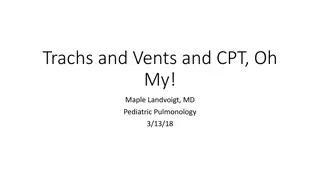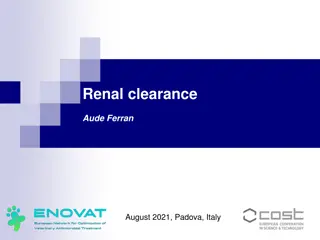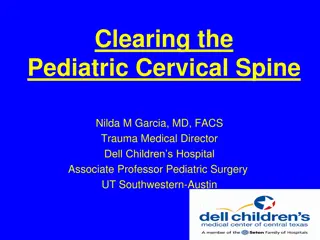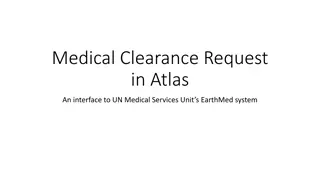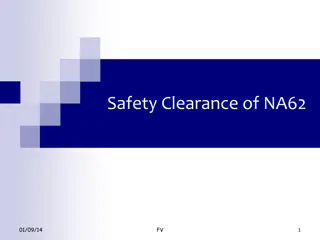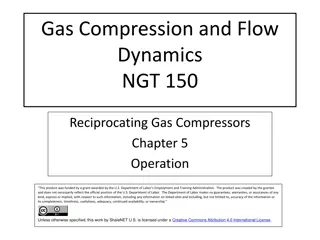Drug Elimination Clearance: Concept and Interpretation
This content delves into the concept, physiological interpretation, and use of drug elimination clearance, covering key aspects such as total clearance, hepatic clearance, renal clearance, and more. Clear explanations and illustrative images aid in understanding the topic.
Download Presentation

Please find below an Image/Link to download the presentation.
The content on the website is provided AS IS for your information and personal use only. It may not be sold, licensed, or shared on other websites without obtaining consent from the author.If you encounter any issues during the download, it is possible that the publisher has removed the file from their server.
You are allowed to download the files provided on this website for personal or commercial use, subject to the condition that they are used lawfully. All files are the property of their respective owners.
The content on the website is provided AS IS for your information and personal use only. It may not be sold, licensed, or shared on other websites without obtaining consent from the author.
E N D
Presentation Transcript
Drug elimination Clearance : Concept, physiological interpretation, and use Alain Bousquet-M lou August 2021, Padua, Italy
Drug elimination and clearances Total or body clearance Body Hepatic clearance Renal clearance Liver Kidneys Urinary excretion Biotransformations Biliary excretion
Clearance concentrations 100 90 80 Rate of concentrations decrease 70 60 50 40 30 20 10 0 0 20 40 60 80 100 time The rate of concentration decrease is lower when concentration is lower The rate of concentration decrease is proportional to the concentration
Clearance Definition (1): Proportionality constant between the rate of elimination rate and the drug concentration rate of elimination Clearance = concentration Instantaneous rate (X = Amount of substance) dX / dt Clearance = C(t)
Clearance Definition (2): Clearance is a measure of the capacity of the body (or an organ) to eliminate a substance after it has reached the general circulation capacity is not synonymous with rate of elimination !
Clearance Dimension 1 Masse Masse Temps Volume 1 = = Clairance Volume Temps 1 Clearance has the dimension of a flow It is expressed in: mL*min-1 or L*h-1
Clearance http://www.icp.org.nz/icp_t1.html click
Clearance Measurement method (1) : ClTotal= DoseIV/ AUC(plasma, blood) IV administration is required !
Clearance Measurement method (2) : concentrations 100 90 AUC(plasma, blood) 80 70 60 50 40 30 20 10 0 0 20 40 60 80 100 time
Clearance ( ) t = Cl C t ( ) (1) Definition: ELIMINATION V Dose (2) Calculation method : Cl =AUC IV TOTALE (3) Clearance model :
A general model for clearance Modelling the extraction rate Q= d bit Blood flow of the organ sanguin de l' organe Q Q Clearing organ C C out in ( ) Q C inC - out ?????????? ???? = ?? ??? ????
A general model for clearance Normalization of the extraction rate Q C 1. In relation to the rate of input : in 1 C 1-E Q Q Clearing organ C out in ( ) ??? ???? ??? Q C inC - out ??? ???? ??? ?????????? ??????????? ? =
A general model for clearance Normalization of the extraction rate Q C 1. In relation to the rate of input : in 1 1-E Clearing organ ??? ???? ??? ??? ???? ??? ?????????? ??????????? ? =
A general model for clearance Normalization of the extraction rate 2. In relation to the input concentration : C in C ( - 1 ) Q Q Q Q Clearing organ C E out in ??? ???? ( ) Q ?? C inC - ??? out ????????? ?? = ???
A general model for clearance Normalization of the extraction rate 2. In relation to the input concentration : C in ( - 1 ) Clearing organ Q Q E ??? ???? ??? ?? ????????? ?? = ???
A general model for clearance Modelling of body clearance Heart Clearing organs (liver, kidneys, other) ????????? ??????= ????????? ???????
A general model for clearance ???????= ??????? ?????? ??????= ????????? ??????? The maximal value of a clearance is a physiological blood flow A clearance will be classified as high or low by comparison to its maximal possible value i.e. by calculating the extraction coefficient The same extraction/clearing capacity leads to different values of clearance for different species
Interspecific comparison of clearances Mammals Exchanges gas Inhalation exhalation Similar anatomical and functional organisation Lung Low perfusion High perfusion Adipose tissue Ingestion Kidney Stomach Urine Intestine Liver Metabolism Faeces
Interspecific comparison of clearances Different physiological parameters Cardiac output (ml/kg/min) 244 146 100-116 86 70-80 75 55 Different clearance values, at identical extraction capacities = 100%. Clearance (ml/kg/min) 122 73 50-58 43 35-40 37.5 27.5
Use of body clearance Determination of a dose Blood concentration associated to the therapeutic effect (PD) ???? 24 =?? ?? ??????? Daily dose PK parameters controlling internal exposure
Doses and clearance http://www.icp.org.nz/icp_t1.html click
Use of body clearance The determination of a dose Individual adaptation of dosages ???? ? =???????????? ??????????? ???? ? ? ?????????? ????????? Interspecific extrapolation of dosages =?????????2 ?????????1 ???? ? ???? ? ? ???????2 ???????1
Interspecific differences of dosages Different physiological parameters Cardiac output (ml/kg/min) 244 146 116 86 80 75 55 Different clearance values, at identical extraction capacities = 100%. Clearance (ml/kg/min) 122 73 58 43 40 37.5 27.5 Different doses per kg, to obtain the same target concentration =1 g/mL Dose /24h (mg/kg) 176 105 84 62 58 54 36
Interspecies extrapolation of doses The doses are proportional to the clearances Morphine, IM Species Proposed dose in clinics (mg/kg) 0.17 0.5 - 2 0.05 0.2 Clearance (mL/kg/min) Calculated dose (mg/kg) Human Dog Cat 14.7 85 8.6 - 1 0.1
Interspecies extrapolation of doses What dose of ketoprofen in goats? 3 mg/kg/24 h Cl = 0.17 L/kg/h : ? Cl = 0.74 L/kg/h Cattle dose (3mg/kg) x Goat Cl (0.74L/kg/h) Cattle Cl (0.17 L/kg/h) Goat dose = Goat dose = 13 mg/kg/24h
Interspecies extrapolation of doses Goats have higher capacity to eliminate drugs than cattle and sheep Higher enzymatic capacities in goats Diet: grass vs. leaves Concentrations in toxic alkaloids Goat is a minor species Using the same dosages (per kg) as cattle : frequent underdosing Treatment failures / worm resistance to ivermectin
Koala: highly specialized diet Toxic eucalyptus leaves Very high enzymatic capacities (liver) Dosage of drugs for koalas Very low oral bioavailability: antibiotics, anti-inflammatory drugs
To summarise: the principles of dose extrapolation based on clearances Allows to estimate the dose in a given (undocumented) individual/species that provides the same plasma exposure as: The known dose in the species/population, for individual adaptation The known dose in a documented species, for extrapolation to another undocumented species Dose 1 Dose 2 Effect 1 = Effect 2 ! Does not correct a pharmacodynamic difference This PD difference will affect the target concentrations
From body clearance to organ clearance
Exchanges gas Inhalation exhalation Lung Low perfusion High perfusion Adipose tissue Ingestion Kidney Stomach Urine Intestine Liver Metabolism Faeces
From body clearance to organ clearance ??????????? ????????= ??????????? ???????????+ ??????????? ????????? ??????????? ???????? ??? ??????????? ???????????+ ??????????? ????????? ??? = Kidneys and liver main purifiers are connected in parallel : Cin-Kidneys = Cin-Liver = Cin ??????????? ???????? ??? ??????????? ??????????? ??? ??????????? ??????????? ??? = + Hepatic and renal clearance are additive ??????= ???????+ ?????????
